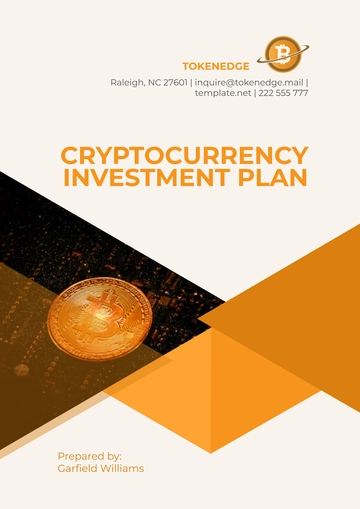Free Finance Credit Control Plan

In pursuit of financial stability, this Finance Credit Control Plan outlines guidelines for prudent credit extension. It covers customer creditworthiness, terms, limits, and approval processes, ensuring effective risk management.
Evaluation of Customer Creditworthiness
To successfully establish a robust credit system, performing an in-depth and comprehensive evaluation of the creditworthiness of customers is essential. This thorough evaluation process involves various stages. The first stage is the analysis of credit scores which provide insight into the customers' credit history. The next stage is an evaluation of the customer's payment history to assess their financial behavior and reliability in paying back debts. The final stage of the assessment process entails examining their income level to determine their financial capacity to repay the credit lent. By integrating these critical elements into the evaluation process, a comprehensive understanding of every customer's ability to repay their credit can be assured. In conclusion, a meticulous customer evaluation is integral to the execution of a sound and secure credit system.
Development of Credit Scoring System
We intend to develop a comprehensive credit scoring system that is aimed at simplifying the complicated process of evaluating a customer's creditworthiness. This system will incorporate pre-determined algorithms specifically designed to calculate and assign a credit score to our customers. Providing a score in this manner has the major advantage of streamlining the extensive procedure of credit approvals, and thus, ensuring a more efficient, time-saving process for both the company and the customers.
Establishment of Credit Terms
To create a comprehensive credit agreement, it is crucial to establish well-defined and standardized credit terms. These are intended to form a fundamental, inseparable component of the credit agreement. Included within these credit terms are numerous aspects that dictate the interaction between the creditor and the customer. Among these are the scheduled dates by which payment is due, the absolute minimum payment amount that needs to be met, and the respective consequences that ensue should a customer fail to make these payments promptly. Importantly, these terms must be communicated in a transparent, easily understood manner to the would-be borrower. This communication must take place before any formal credit is granted. Each of these combined steps ensures that a possibly complicated financial arrangement remains manageable and clear for all involved parties.
Definition of Credit Limits
The objective of defining credit limits is to establish clear parameters for extending credit, ensuring a balanced approach that mitigates risk while facilitating business transactions. The following criteria will be considered for determining and managing credit limits:
Criteria | Description |
|---|---|
Customer Credit Score | Evaluate credit scores based on reliable credit reports, reflecting historical payment behavior. |
Financial Statements | Assess the financial health of the customer through analysis of income statements and balance sheets. |
Payment History | Review the customer's payment history to identify patterns of prompt payment or delays. |
Industry and Market Trends | Consider the economic conditions, industry trends, and market outlook affecting the customer. |
Credit Limit Parameters:
Parameter | Description |
|---|---|
Maximum Credit Limit | The highest amount of credit that can be extended to a customer, considering the above criteria. |
Initial Credit Limit | The starting credit limit granted to a new customer is subject to review based on performance and payment history. |
Credit Limit Review Frequency | Specify the frequency of reviews to ensure ongoing appropriateness of credit limits (e.g., quarterly, annually). |
Adjustments and Revisions | Define the process for adjusting credit limits based on changes in the customer's financial condition or performance. |
Special Considerations | Identify any special considerations or conditions that may affect the determination or adjustment of credit limits. |
Approval Processes
It is essential to establish a uniform standard procedure for the approval of credit to maintain consistency across all operations and to prevent the existence of any biases. With this in place, all approvals will ultimately be determined based solely on a comprehensive evaluation of the individual's creditworthiness and their corresponding credit scoring system. This will help to ensure a high level of transparency and integrity within the credit approval process.
Training of Staff
It is of crucial importance that the individuals who are a part of the company's staff and are involved in the process of extending credit to clients must undergo efficient and effective training. This essential training should cover a comprehensive understanding of the company’s credit policies, the specific terms related to the extension of credit, and an in-depth knowledge of the company's credit approval process. This exercise in training is a fundamental part of their role because it allows them to contribute to the company's overall approach to credit risk management, ensuring its consistent implementation across the entire company. Overall, this ensures that the process of extending credit and assessing credit risks adheres to the company’s set procedures and standards, thus minimizing financial exposure and potential losses. Therefore, this training not only equips them with the necessary tools and skills to perform their duties efficiently but also aids in the proper functioning and fiscal sustainability of the company.
Implementation of Credit Management Software
The smooth implementation of credit management software could yield substantial benefits, particularly when it comes to systematically managing the entire credit process. This type of software is equipped with numerous capabilities that are designed to make credit management more efficient and error-free. For instance, it can effectively manage all relevant customer data. In addition to that, the software can take over the task of credit scoring, which, when done manually, can potentially lead to mistakes. Credit limits can also be managed through the software, ensuring that there are no discrepancies. Furthermore, the credit management software comes with the ability to automate certain approval processes. This means that tasks that used to require human intervention can now be completed in an automated manner, saving more time and resources. Therefore, employing the use of credit management software can significantly streamline operations related to credit management.
Periodic Review of Credit Policies
The importance of regularly reviewing and updating credit policies cannot be overstated. This is essential to adapt to the ever-changing market conditions and the evolving behaviors of customers. By not conducting these regular reviews and updates, a business would potentially miss out on a lot of vital information and opportunities and, as a result, fail to stay relevant to its customers and the market. Key components that need to be analyzed during this review process include credit limit utilization, the repayment capabilities of customers, as well as the default rates. Analyzing credit limit utilization is important to know if customers are making good use of their available credit or if they are over-utilizing, indicating potential financial stress. Scrutinizing the repayment capabilities of customers, on the other hand, is significant to ensure whether they have the means to repay their debts or not, which has a direct impact on the portfolio quality. Furthermore, monitoring the default rates will provide an understanding of the creditworthiness of customers and help anticipate potential losses. Therefore, this regular analysis is crucial to help construct an accurate and up-to-date representation of a company's credit policies and customer behaviors, enabling it to remain flexible and responsive to changes. It all contributes to the larger objective of leveraging the best business opportunities and mitigating possible risks.
Address of Delinquencies
It is important to construct a well-articulated plan that clearly outlines the steps to be taken in instances of late payments and potential defaults. Having a comprehensive blueprint to tackle such issues becomes crucial in safeguarding the financial interests of the organization. In addition, having such well-defined policies helps ensure that everyone is treated fairly and consistently when dealing with late payments and defaults. Such precautionary measures can also contribute to maintaining a peaceful relationship with the customers.
Compliance with Regulatory Standards
All policies and processes related to credit within an organization must align with both local and national financial regulations. By adhering to these regulations, the organization can ensure its compliance in all financial matters on credit. It's critical to understand that this level of compliance not only helps maintain the credibility and integrity of the organization but also ensures that it stays free from any potential legal issues that could arise in extending credit. In essence, complying with local and national financial regulations is a beneficial practice, not just in structured administration and maintaining business standing, but also in preventing unwanted legal repercussions concerning credit extension.
- 100% Customizable, free editor
- Access 1 Million+ Templates, photo’s & graphics
- Download or share as a template
- Click and replace photos, graphics, text, backgrounds
- Resize, crop, AI write & more
- Access advanced editor
Discover financial stability with the Finance Credit Control Plan Template from Template.net. This editable and customizable template, powered by an intuitive AI editor tool, empowers you to establish clear guidelines for credit extension and risk management. Effortlessly tailor the plan to your needs, ensuring a balanced approach for sustainable financial growth.
You may also like
- Finance Plan
- Construction Plan
- Sales Plan
- Development Plan
- Career Plan
- Budget Plan
- HR Plan
- Education Plan
- Transition Plan
- Work Plan
- Training Plan
- Communication Plan
- Operation Plan
- Health And Safety Plan
- Strategy Plan
- Professional Development Plan
- Advertising Plan
- Risk Management Plan
- Restaurant Plan
- School Plan
- Nursing Home Patient Care Plan
- Nursing Care Plan
- Plan Event
- Startup Plan
- Social Media Plan
- Staffing Plan
- Annual Plan
- Content Plan
- Payment Plan
- Implementation Plan
- Hotel Plan
- Workout Plan
- Accounting Plan
- Campaign Plan
- Essay Plan
- 30 60 90 Day Plan
- Research Plan
- Recruitment Plan
- 90 Day Plan
- Quarterly Plan
- Emergency Plan
- 5 Year Plan
- Gym Plan
- Personal Plan
- IT and Software Plan
- Treatment Plan
- Real Estate Plan
- Law Firm Plan
- Healthcare Plan
- Improvement Plan
- Media Plan
- 5 Year Business Plan
- Learning Plan
- Marketing Campaign Plan
- Travel Agency Plan
- Cleaning Services Plan
- Interior Design Plan
- Performance Plan
- PR Plan
- Birth Plan
- Life Plan
- SEO Plan
- Disaster Recovery Plan
- Continuity Plan
- Launch Plan
- Legal Plan
- Behavior Plan
- Performance Improvement Plan
- Salon Plan
- Security Plan
- Security Management Plan
- Employee Development Plan
- Quality Plan
- Service Improvement Plan
- Growth Plan
- Incident Response Plan
- Basketball Plan
- Emergency Action Plan
- Product Launch Plan
- Spa Plan
- Employee Training Plan
- Data Analysis Plan
- Employee Action Plan
- Territory Plan
- Audit Plan
- Classroom Plan
- Activity Plan
- Parenting Plan
- Care Plan
- Project Execution Plan
- Exercise Plan
- Internship Plan
- Software Development Plan
- Continuous Improvement Plan
- Leave Plan
- 90 Day Sales Plan
- Advertising Agency Plan
- Employee Transition Plan
- Smart Action Plan
- Workplace Safety Plan
- Behavior Change Plan
- Contingency Plan
- Continuity of Operations Plan
- Health Plan
- Quality Control Plan
- Self Plan
- Sports Development Plan
- Change Management Plan
- Ecommerce Plan
- Personal Financial Plan
- Process Improvement Plan
- 30-60-90 Day Sales Plan
- Crisis Management Plan
- Engagement Plan
- Execution Plan
- Pandemic Plan
- Quality Assurance Plan
- Service Continuity Plan
- Agile Project Plan
- Fundraising Plan
- Job Transition Plan
- Asset Maintenance Plan
- Maintenance Plan
- Software Test Plan
- Staff Training and Development Plan
- 3 Year Plan
- Brand Activation Plan
- Release Plan
- Resource Plan
- Risk Mitigation Plan
- Teacher Plan
- 30 60 90 Day Plan for New Manager
- Food Safety Plan
- Food Truck Plan
- Hiring Plan
- Quality Management Plan
- Wellness Plan
- Behavior Intervention Plan
- Bonus Plan
- Investment Plan
- Maternity Leave Plan
- Pandemic Response Plan
- Succession Planning
- Coaching Plan
- Configuration Management Plan
- Remote Work Plan
- Self Care Plan
- Teaching Plan
- 100-Day Plan
- HACCP Plan
- Student Plan
- Sustainability Plan
- 30 60 90 Day Plan for Interview
- Access Plan
- Site Specific Safety Plan





























